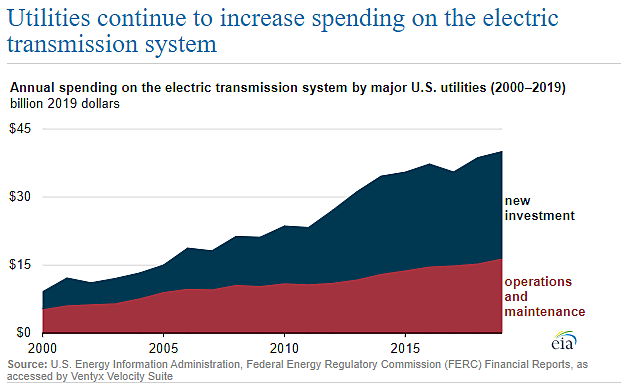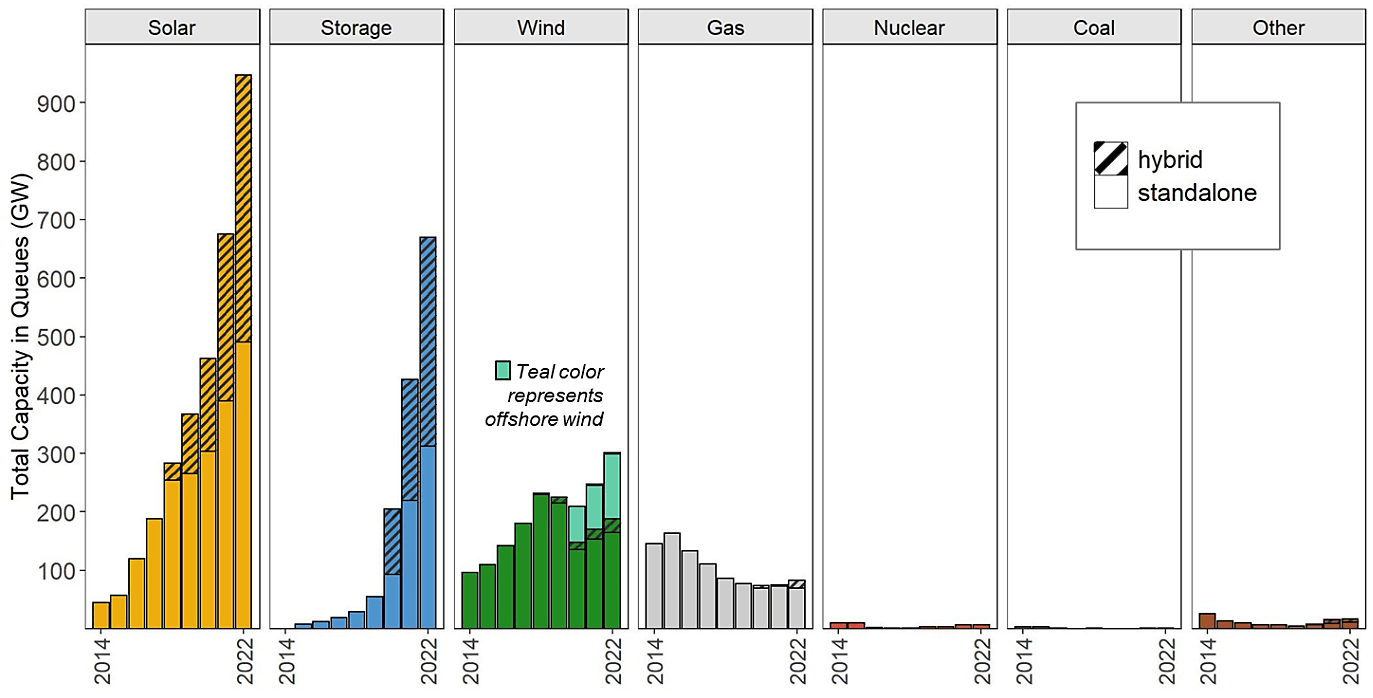Economics
How Subsidies in the Inflation Reduction Act Undermine Transmission Reform
Before committing to large‐scale transmission expansion, Congress should eliminate the open‐ended generation subsidies in the IRA.

A previous post showed that the total cost of the Inflation Reduction Act’s (IRA’s) energy subsidies could reach $3 trillion. Subsidies so large cause a lot of problems—one being that advocates of a robust electricity infrastructure, like me, are now skeptical of using federal policy to expand the transmission system, which is the network of high‐voltage wires and substations that make up the backbone of the power grid.
Before committing to large‐scale transmission expansion, Congress should eliminate the open‐ended generation subsidies in the IRA. Energy producers can’t capture the IRA’s lucrative production tax credits until they connect their new energy projects to the grid, so more transmission without amending the IRA means more subsidies at enormous cost to taxpayers.
The Green Transition Requires Transmission
Experts across the electricity industry argue that we need more transmission—bigger networks and massive transmission development—and we need it immediately. For example, the U.S. Department of Energy under President Biden and academic advocates of “net zero” policies are calling for aggressive expansion of the transmission system. Proponents of aggressive transmission expansion have a catchphrase: “There is no transition without transmission.” That is certainly true in the case of a transition to generation resources like wind and solar energy, which tend to be located far from demand centers.
However, heeding their call without first addressing the potential to spend $3 trillion on electricity generation subsidies is not a conservative or free‐market approach. Congress should remove the IRA subsidies for mature generation technologies like wind and solar to encourage smart transmission investments that leave electricity customers and federal taxpayers better off. If the IRA subsidies remain in place through a period of rapid transmission expansion, the cost to American taxpayers and electricity customers will escalate.
The required amount of transmission is not small or cheap. Transmission advocates at Americans for a Clean Energy Grid cite the Princeton Net Zero report, which indicates that “high voltage transmission will need to double by 2030, at a cost of $360 billion, and triple by 2050, at a cost of $2.2 trillion, to achieve a zero‐carbon future by 2050.” Keep in mind this estimated cost of $2.2 trillion is in addition to the $2.5 to $3 trillion in subsidies for generators.
Some investment is necessary to maintain the existing transmission system. However, calls to double or triple the high‐voltage transmission are a far cry from the $15–20 billion spent annually by utilities on operating and maintaining the grid. Further, transmission spending has already been on a steep upward trend for several years, not just from increased operations and maintenance costs but also from an increase in spending on new projects, as illustrated by data from the U.S. Energy Information Administration below.
Source: https://www.eia.gov/todayinenergy/detail.php?id=47316
Major Transmission Expansion Will Increase the Burden on Taxpayers
Policymakers need to understand that transmission expansion can have serious costs because it is the missing link between subsidy‐hungry developers of generation projects and the $3 trillion pot of cash from Congress.
Today, the lack of available transmission is a barrier to new generation technologies eligible for the tax credits in the IRA—for example, generators can only claim the Production Tax Credit (PTC) if they are able to produce energy and deliver it to the grid. Further, the IRA subsidies for electricity production all become PTCs beginning in 2025, so the pressure to expand transmission will only grow in the coming years. But “removing” that barrier by expanding the transmission system would be bad for taxpayers because it would put the PTC on steroids, at taxpayers’ expense. This fits with Ludwig von Mises’ observation that government intervention in markets begets more intervention—in this case, subsidies for generation beget federal intervention in transmission.
The subsidy flood would be substantial. At the end of 2022, the United States had more solar and wind energy projects vying to connect to the grid (1,247 gigawatts) than the total generating capacity of the existing system (1,199 gigawatts). Expanding the transmission system and giving these resources access to the grid will expose taxpayers to trillions in generation subsidies.
Source: https://emp.lbl.gov/queues
Given this backlog of subsidy‐eligible projects, the consumer‐ and taxpayer‐friendly approach to transmission expansion hinges on whether Congress can remove the IRA’s subsidies for electricity generation first. Commissioner James Danly of the Federal Energy Regulatory Commission (FERC) summarized the issue during a House Energy and Commerce Committee hearing in May of this year [at 33:15]:
“There’s been this move afoot in which markets have become something closer to a mechanism by which to harvest these subsidies, rather than what they were intended to do, which is ensure least cost dispatch of available resources and to incentivize new investment. And the largest barrier at the moment to the harvesting of those subsidies is the physical interconnection of what are typically remotely located resources to the markets. You can’t get, for example, the production tax credit if you aren’t connected to a market and you don’t sell. And so there has been this concomitant effort to either mandate or speed the development of transmission… . It would be a shame if we removed and socialized the cost of the development of this transmission because, at the moment at any rate, the cost of interconnecting to the electric system is one of the few disciplining factors remaining in the development of infrastructure… .[emphasis added]”
Commissioner Danly is right to be skeptical of subsidy harvesters. In addition to the existing subsidies for electricity generation, there is also a debate about whether Congress should subsidize transmission itself, as with a federal investment tax credit. But Congress could also inflict harm by simply mandating that utilities build more transmission. One example is the Big Wires Act, which would require a large increase in interregional transmission without first addressing IRA subsidies. With the IRA subsidies in place, such a mandate should be a non‐starter for anyone concerned about federal spending, impacts on taxpayers, and the overall cost of the electricity system (which consumers always pay, either in retail electricity bills or in taxes).
The Federal Energy Regulatory Commission (FERC) could also get involved in transmission expansion. The agency has explored the question of requiring a minimum level of interregional transmission, and it could move forward with a rulemaking on the issue at any time. In addition to establishing minimum levels of interregional transmission, FERC could also socialize the cost of transmission upgrades by allocating the costs widely in the form of higher prices for all ratepayers.
So‐called “cost allocation”—which boils down to spending other people’s money—has long been a priority for those who want to rapidly expand the transmission system. If the cost of transmission expansion falls on all ratepayers, Americans could pay trillions in generation subsidies through federal taxes in addition to trillions in transmission expansion costs through higher retail electricity prices.
Congress and FERC should set aside transmission reform efforts until lawmakers address the staggering costs of the IRA’s generation subsidies. Only after reining in the IRA’s energy subsidies should policymakers debate how to expand the transmission system, and the policy goal should be to provide reliable electricity at the lowest total cost to consumers and taxpayers.
Conclusion
Before committing to large‐scale transmission expansion, Congress should eliminate the open‐ended generation subsidies in the IRA. There is a legitimate need for transmission expansion when and where it can reduce the total cost of electricity service or increase reliability. However, policymakers in Congress and at FERC should be careful not to run headlong into transmission expansion schemes that only serve the interests of IRA subsidy harvesters and leave U.S. taxpayers with a $3 trillion tab.

Argentina Is One of the Most Regulated Countries in the World
In the coming days and weeks, we can expect further, far‐reaching reform proposals that will go through the Argentine congress.
Crypto, Crude, & Crap Stocks Rally As Yield Curve Steepens, Rate-Cut Hopes Soar
Crypto, Crude, & Crap Stocks Rally As Yield Curve Steepens, Rate-Cut Hopes Soar
A weird week of macro data – strong jobless claims but…
Fed Pivot: A Blend of Confidence and Folly
Fed Pivot: Charting a New Course in Economic Strategy Dec 22, 2023 Introduction In the dynamic world of economics, the Federal Reserve, the central bank…

















